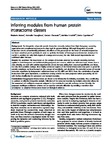Inferring modules from human protein interactome classes
| dc.contributor.author | Marras, E | |
| dc.contributor.author | Travaglione, A | |
| dc.contributor.author | Chaurasia, G | |
| dc.contributor.author | Futschik, Matthias | |
| dc.contributor.author | Capobianco, E | |
| dc.date.accessioned | 2017-02-07T19:44:43Z | |
| dc.date.available | 2017-02-07T19:44:43Z | |
| dc.date.issued | 2010-12 | |
| dc.identifier.issn | 1752-0509 | |
| dc.identifier.issn | 1752-0509 | |
| dc.identifier.other | 102 | |
| dc.identifier.uri | http://hdl.handle.net/10026.1/8402 | |
| dc.description.abstract |
<jats:title>Abstract</jats:title> <jats:sec> <jats:title>Background</jats:title> <jats:p>The integration of protein-protein interaction networks derived from high-throughput screening approaches and complementary sources is a key topic in systems biology. Although integration of protein interaction data is conventionally performed, the effects of this procedure on the result of network analyses has not been examined yet. In particular, in order to optimize the fusion of heterogeneous interaction datasets, it is crucial to consider not only their degree of coverage and accuracy, but also their mutual dependencies and additional salient features.</jats:p> </jats:sec> <jats:sec> <jats:title>Results</jats:title> <jats:p>We examined this issue based on the analysis of modules detected by network clustering methods applied to both integrated and individual (disaggregated) data sources, which we call interactome classes. Due to class diversity, we deal with variable dependencies of data features arising from structural specificities and biases, but also from possible overlaps. Since highly connected regions of the human interactome may point to potential protein complexes, we have focused on the concept of modularity, and elucidated the detection power of module extraction algorithms by independent validations based on GO, MIPS and KEGG. From the combination of protein interactions with gene expressions, a confidence scoring scheme has been proposed before proceeding via GO with further classification in permanent and transient modules.</jats:p> </jats:sec> <jats:sec> <jats:title>Conclusions</jats:title> <jats:p>Disaggregated interactomes are shown to be informative for inferring modularity, thus contributing to perform an effective integrative analysis. Validation of the extracted modules by multiple annotation allows for the assessment of confidence measures assigned to the modules in a protein pathway context. Notably, the proposed multilayer confidence scheme can be used for network calibration by enabling a transition from unweighted to weighted interactomes based on biological evidence.</jats:p> </jats:sec> | |
| dc.format.extent | 102- | |
| dc.format.medium | Electronic | |
| dc.language | en | |
| dc.language.iso | eng | |
| dc.publisher | Springer Science and Business Media LLC | |
| dc.subject | Algorithms | |
| dc.subject | Calibration | |
| dc.subject | Humans | |
| dc.subject | Molecular Sequence Annotation | |
| dc.subject | Protein Binding | |
| dc.subject | Protein Interaction Mapping | |
| dc.subject | Proteins | |
| dc.subject | Proteomics | |
| dc.subject | Reproducibility of Results | |
| dc.subject | Systems Biology | |
| dc.title | Inferring modules from human protein interactome classes | |
| dc.type | journal-article | |
| dc.type | Journal Article | |
| dc.type | Research Support, Non-U.S. Gov't | |
| plymouth.author-url | https://www.webofscience.com/api/gateway?GWVersion=2&SrcApp=PARTNER_APP&SrcAuth=LinksAMR&KeyUT=WOS:000282256500001&DestLinkType=FullRecord&DestApp=ALL_WOS&UsrCustomerID=11bb513d99f797142bcfeffcc58ea008 | |
| plymouth.issue | 1 | |
| plymouth.volume | 4 | |
| plymouth.publication-status | Published | |
| plymouth.journal | BMC Systems Biology | |
| dc.identifier.doi | 10.1186/1752-0509-4-102 | |
| plymouth.organisational-group | /Plymouth | |
| plymouth.organisational-group | /Plymouth/Faculty of Health | |
| plymouth.organisational-group | /Plymouth/Users by role | |
| dc.publisher.place | England | |
| dcterms.dateAccepted | 2010-07-23 | |
| dc.identifier.eissn | 1752-0509 | |
| dc.rights.embargoperiod | Not known | |
| rioxxterms.versionofrecord | 10.1186/1752-0509-4-102 | |
| rioxxterms.licenseref.uri | http://www.rioxx.net/licenses/all-rights-reserved | |
| rioxxterms.licenseref.startdate | 2010-07-23 | |
| rioxxterms.type | Journal Article/Review |


